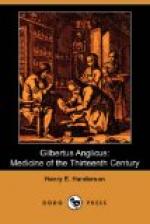The chapter on hematuria presents a very curious specimen of medieval pathology. Gilbert says: “The escape of blood in the urine is due sometimes to the liver, sometimes to the bile,[7] sometimes to the kidneys and loins, sometimes to the bladder. If the blood is pure and clear, in large quantity, mixed perfectly with the urine and accompanied by pain in the right hypochondrium, it comes from the liver. Such urine presents scarcely any sediment. If the blood comes from the lrili vein, it is also rather pure, but less pure than in the former case, nor is the quantity so great, while pain is felt over the region of the seventh vertebra, counting from below. If it comes from the kidneys, it is scanty and pure as it leaves the bladder, but soon coagulates and forms a dark deposit in the vessel, while pain is felt in the pubes and peritoneum.... If pus, blood and epithelium (squamae) are passed, and the odor is strong, it signifies ulceration of the bladder” (f. 275b).
[Footnote 7: In his chapter on embryology (f. 304c) Gilbert describes the lrili vein as follows: “The embryo is nourished by means of the lrili or lrineli vein, which does not exist in man. This vein has its origin in the liver and divides into two branches. Of these the superior branch bifurcates, and one of its branches goes to the right breast, the other to the left, conveying blood from the liver. This blood in the breast is bleached white (dealbatur) like milk, and forms the nourishment of the infant. The inferior branch of the lrili vein also bifurcates, sending one of its branches to the right cornu of the uterus, the other to the left. These vessels carry blood into the cotyledons, whence it is transmitted to the fetus and digested by its digestive faculty.”]
Diabetes is defined as “An immoderate passage or attraction of urine from the liver to the kidneys and its passage through the kidneys, as the result of a warm or dry distemperature of these organs.” The idea of some association of the liver and kidneys in the production of diabetes is at least as old as the eleventh century, and Gilbert’s definition of the disease is undoubtedly borrowed from the “Practica” of John Platearius (A.D. 1075), of the school of Salernum. The symptoms, continual thirst, dryness of the mouth, emaciation, in spite of an inordinate appetite, frequent and profuse urination, are correctly given, but no knowledge of the presence of sugar in the urine is indicated.
Dyampnes (involuntary micturition) claims a page or more of explanation and treatment, and its frequent occurrence in old men and children is noticed.
In the department of the diseases of women chapters are devoted to amenorrhea, menorrhagia, hysteria (suffocatio matricis), prolapse, ulceration, abscess, cancer, dropsy and “ventosity” of the uterus (physometra).




